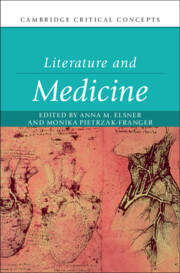Book contents
- Literature and Medicine
- Cambridge Critical Concepts
- Literature and Medicine
- Copyright page
- Dedication
- Contents
- Figures
- Contributors
- Acknowledgements
- Medico-Literary Pathways, Crossroads, and Side Streets
- Part I Origins: Histories
- Part II Developments: Forms
- Chapter 6 Illness and the ‘Fall’ of Language
- Chapter 7 Translating Chronic Pain and the Ethics of Reading in the Personal Essay
- Chapter 8 Physician-Poets and Vitalist Theories of Life
- Chapter 9 Healthcare Anecdotes and the Medically Anecdotal
- Chapter 10 Literary Realism and Mental Breakdown
- Chapter 11 Time and Narrative in the Age of Postnatural Death
- Chapter 12 Performance and/as Contagion in the Time of the COVID-19 Pandemic
- Chapter 13 The Parallel Chart as Medico-Literary Practice
- Chapter 14 Articulating the Experiential in Graphic Medicine
- Part III Applications: Politics
- Afterword
- Index
Chapter 8 - Physician-Poets and Vitalist Theories of Life
from Part II - Developments: Forms
Published online by Cambridge University Press: 17 January 2024
- Literature and Medicine
- Cambridge Critical Concepts
- Literature and Medicine
- Copyright page
- Dedication
- Contents
- Figures
- Contributors
- Acknowledgements
- Medico-Literary Pathways, Crossroads, and Side Streets
- Part I Origins: Histories
- Part II Developments: Forms
- Chapter 6 Illness and the ‘Fall’ of Language
- Chapter 7 Translating Chronic Pain and the Ethics of Reading in the Personal Essay
- Chapter 8 Physician-Poets and Vitalist Theories of Life
- Chapter 9 Healthcare Anecdotes and the Medically Anecdotal
- Chapter 10 Literary Realism and Mental Breakdown
- Chapter 11 Time and Narrative in the Age of Postnatural Death
- Chapter 12 Performance and/as Contagion in the Time of the COVID-19 Pandemic
- Chapter 13 The Parallel Chart as Medico-Literary Practice
- Chapter 14 Articulating the Experiential in Graphic Medicine
- Part III Applications: Politics
- Afterword
- Index
Summary
Poetry and medicine have long been intimately linked. William Carlos Williams noted in a worn prescription pad that the ‘use of poetry is to vivify’. Poetry has a history of being used to define life in ways that medical language sometimes cannot. This chapter traces the intersection of poetry and medicine through the figure of the physician-poet, specifically in the eighteenth century. It explores how poetry has been used to question what medical theories mean for broader philosophical questions about the human body and the self. Through poetic works by Sir Richard Blackmore, Samuel Garth, John Arbuthnot, and John Armstrong, this chapter places Williams’s note on poetry’s vivifying quality in the history of physicians using poetry to explore and define aspects of life within the human body.
Keywords
- Type
- Chapter
- Information
- Literature and Medicine , pp. 137 - 151Publisher: Cambridge University PressPrint publication year: 2024

